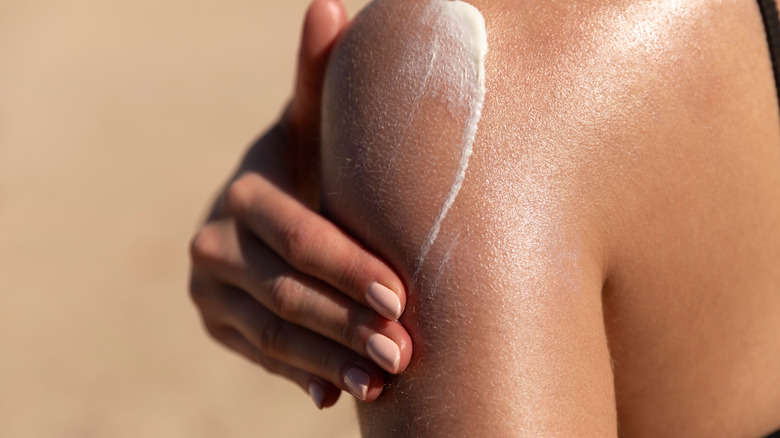Just How Dangerous Is Oxybenzone In Sunscreen?
In recent times, there's been a significant shift in how we approach buying beauty, skin, and haircare products. We've increasingly found ourselves questioning the ingredients we commonly see listed on the back of these products. All this head-scratching has had a positive impact because it's led us to become more aware of the potentially harmful effects of certain ingredients.
Many of us have sought to avoid products with notorious ingredients like parabens and sulfates and opted for clean beauty products instead. Some have even pivoted to conscious, or greener, beauty alternatives that strive to do better for the environment with fewer chemicals and minimalist packaging. We're slowly learning to refuse anything that may be damaging to us or the planet. While we're focusing on the chemicals in our shampoos, soaps, and foundations, we might be letting one sneak by in a place we least expect: our sunscreen.
Applying sunscreen is a vital part of any good skincare routine because it helps protect us from the sun's damaging rays, but it may not be 100% harmless for you because of chemically-derived ingredients like oxybenzone. For the uninitiated, oxybenzone is a controversial chemical compound found in several over-the-counter sunscreens, per Minimalist. In fact, its continued use in sunscreen has been highly debated by experts and authorities as they try to determine if the good outweighs the bad.
The potential harms of using a sunscreen with oxybenzone
Despite its potential problems, you'll find oxybenzone is commonly used in sunscreen because it absorbs the harmful UVA and UVB rays that emit from the sun to prevent them from burrowing deep into your skin and causing damage to your most important cells, per Healthline. But there's slightly more to it than that because studies have revealed some problematic things that might make you think twice about using sunscreen with oxybenzone regardless of its ubiquity.
Multi-specialist physician Azza Halim, MD, discussed the potential harms of oxybenzone with PopSugar, sharing: "We do know that oxybenzone has been attributed to hormone/endocrine disruption, and it's been found in breast-milk samples of lactating mothers." She added, "Research has shown a potential link between oxybenzone and lower testosterone levels in adolescent boys, hormone changes in men, and shorter pregnancies and disrupted birth weights in babies."
Likewise, if you have sensitive skin, it might be a good idea to find an oxybenzone-free sunscreen because it's allergenic and can cause severe skin problems (via The Journal of Allergy and Clinical Immunology). An FDA study confirmed that active ingredients like oxybenzone get absorbed into your bloodstream after application but the repercussions aren't known yet. Moreover, oxybenzone's negative impact on coral life led to a ban on its use in sunscreens in Hawaii.
It's important to pick the right sunscreen to protect your skin
Thankfully, you can avoid the risks associated with a chemical-based sunscreen by opting for a mineral (aka physical) one instead. A mineral sunscreen, for instance, utilizes minerals like titanium dioxide or zinc oxide. Both ingredients are Generally Recognized As Safe And Effective (GRASE) by the FDA. Instead of penetrating your skin like a chemical sunscreen, a physical or mineral sunscreen sits on top of your skin to reflect the harmful UV rays by creating a physical shield.
With mineral sunscreen, you get all the protective benefits of a chemical-based sunscreen and then some. As board-certified dermatologist Dr. Elizabeth Hale, MD, explained to Healthline: "They also offer the most broad-spectrum protection (against both UVA and UVB rays) and are widely recommended for those that apply sunscreen to their face and neck daily, as they work to prevent year-round UVA damage including wrinkles, brown spots, and photoaging." She also mentioned that zinc oxide sunscreens might be a good option for people with sensitive skin and children, in particular.
When she spoke to PopSugar, Dr. Halim listed out everything we should be looking for in sunscreen. "The fewer ingredients in a product, the better, which is why when looking for an effective sunscreen, one can find plenty of physical sunblocks that [contain] only two ingredients: zinc oxide and titanium dioxide with an SPF of 50 to ward off both UVA and UVB," she clarified. Thus, keep it simple, keep it safe.


